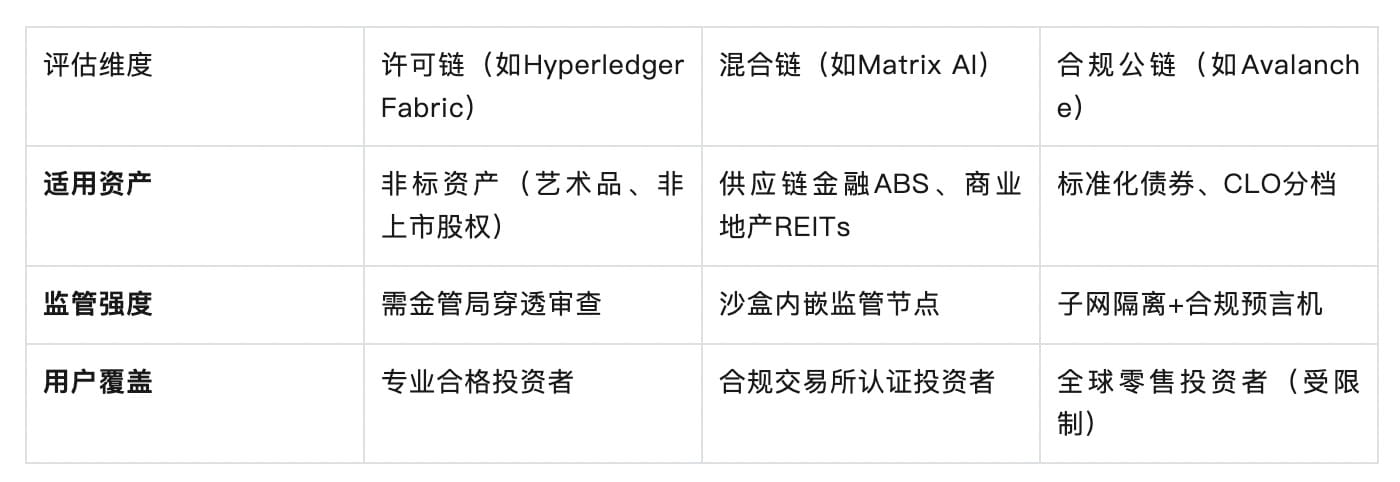Written by: Zhang Feng
With the official implementation of the Hong Kong (Stablecoin Regulation) in 2025, and the deepening of the regulatory sandbox mechanism by the Monetary Authority, physical assets such as photovoltaic power plants, commercial real estate, and supply chain finance from mainland China are flowing into the global capital market in token form via Hong Kong.
However, under the policy dividend, a key choice determines the success or failure of the project—how to choose blockchain infrastructure that deeply aligns with the Hong Kong regulatory framework? This decision not only affects technical feasibility but also determines whether the project can cross the compliance chasm and gain market trust.

1. Performance and Security Requirements
In Hong Kong's strict RWA regulatory environment, the performance and security of the underlying blockchain are not just technical issues but a lifeline for project survival. From sandbox practices, successful cases generally exhibit three major technical commonalities.
High Concurrency Processing Determinism: Some RWA projects similar to REITs need to achieve T+1 settlement, requiring the blockchain to handle thousands of transactions per second while ensuring the irreversibility of transactions. Moreover, some projects with high requirements for secondary trading need to effectively prevent the risk of CLO tranches being accidentally traded during the rebalancing process, requiring sub-second processing technology. This determinism is crucial for financial-grade applications.
Enterprise-level privacy and cross-chain compatibility: The Hong Kong Monetary Authority has stringent privacy protection requirements for asset data. It is generally believed that adopting permissioned chain architectures such as Hyperledger Fabric allows participating nodes to complete audit penetration while protecting sensitive commercial information. Smart contract security and oracle reliability: The experiences of some projects that were urgently halted due to asset authenticity vulnerabilities indicate that contracts not subject to strict audits are akin to financial time bombs. Meanwhile, some projects use a dual oracle system composed of Chainlink and API3 to provide price feed services for cash flow assets like photovoltaic power station revenue rights, ensuring on-chain prices are closely anchored to the real world.
2. Embedded Regulatory Compliance Requirements
The Hong Kong RWA sandbox is by no means a technical testing ground, but a testing stage for regulatory compliance. Blockchain infrastructure must embed compliance capabilities to avoid legal hard landings in the later stages.
License Compatibility and Regulatory Interfaces: According to the Hong Kong Securities and Futures Commission's requirements, the issuance of tokenized REITs must go through Article 103 review, and underwriters must hold a Type 1 license. Therefore, the relevant blockchain is designed to create regulatory nodes, allowing the Monetary Authority to monitor on-chain transactions in real time while isolating sensitive commercial data. This 'visible but untouchable' regulatory-friendly architecture becomes the admission ticket for sandbox projects.
Identity Compliance and AML Mechanism: Participation in RWA transactions using anonymous wallets is a red line in Hong Kong. Therefore, blockchain needs to integrate an AI behavior modeling engine to dynamically analyze address associations. Both compliant RWA asset issuance platforms and DeFi platforms must rely on professional KYC service providers to ensure that relevant accounts meet the compliance trading requirements for related products, while also relying on on-chain AML firewalls to track the flow of funds throughout.
Legal Entity Mapping and Jurisdiction Weight: A project in Singapore directly encoded fund contract terms into a smart contract, triggering legal effect automatically upon token transfer. This requires the blockchain to support legal smart contracts, clearly stipulating the jurisdiction of Hong Kong courts and the dispute resolution mechanism to avoid decentralized technology undermining local judicial authority.
3. Penetration Verification of Asset Credibility
The core risk of RWA projects lies in the skepticism of 'air assets'—the blockchain must establish a fully verifiable path from on-chain tokens to off-chain assets throughout the lifecycle.
Asset Anchoring and Custody Proof: When U.S. Treasury bonds are tokenized, top-tier banks issue daily reserve audit reports and hash them on-chain, allowing investors to verify custody status at any time. This 'off-chain custody + on-chain verification' model has become the compliance norm. Hong Kong further requires a 20% cash reserve pool (e.g., USDC) to cope with redemption fluctuations.
Cash flow automation and permission layering: After tokenization of revenue rights such as commercial real estate rents, it is necessary to ensure automatic distribution of income to holders. At this point, it may be necessary to automatically distribute dividends through smart contracts and establish permission levels for managing sensitive data. For example, a photovoltaic power station project implements income flow distribution with second-level precision through the ERC-3643 token standard.
Cross-chain Risk Isolation: Some projects attempt multi-chain issuance to disperse risks, but Hong Kong regulatory authorities prefer a main chain + subnet architecture. Some projects isolate different levels of assets (e.g., U.S. Treasury bonds and high-risk CLOs) through subnets to avoid risk contagion. This 'risk bulkhead' design aligns with the Monetary Authority's core demand for financial stability.
4. Legal Remedies for Rights Protection
When choosing a blockchain, one must remember: behind every token lies a legally protected property right, and the infrastructure must construct end-to-end protection for investors.
On-chain governance and investor empowerment: Some projects allow token holders to participate directly in governance voting and receive income through integrated Web 3 wallets, with their smart contracts automatically executing the voting results to ensure that power is not intercepted by the project party. For instance, under this design, if an RWA project needs to change decisions regarding asset disposal, it may achieve collective decision-making within hours.
Payment Guarantees and Clearing Priorities: When underlying assets default (e.g., accounts receivable not collected), the blockchain must clarify the clearing order of various tokens. The smart contracts of related RWA projects automatically freeze risk classifications and prioritize payment to higher-level holders, with rule execution transparency far exceeding traditional finance.
Dispute Resolution and Judicial Connection: A certain commercial real estate project preset arbitration clauses in its smart contract. When lease disputes trigger on-chain alarms, the system automatically freezes related asset income streams and initiates Hong Kong arbitration procedures. This 'code + law' dual-trigger mechanism avoids investors falling into a technical maze of rights protection dilemmas.
5. Strategic Recommendations: Scenario-based Blockchain Selection Framework
Faced with diverse technological options, project parties should abandon single-indicator determinism such as 'only TPS' and instead conduct a three-dimensional assessment of regulatory adaptability, technical feasibility, and asset matching degree:

High-value Non-standard Assets: Permissioned Chains Preferred: For complex targets such as artworks and unlisted equity, selecting permissioned chains like Hyperledger Fabric, with private channels opened to regulators, is preferred. It is necessary to accompany with legal opinions to clarify token attributes (to avoid disputes over securities recognition) and the exclusive jurisdiction of Hong Kong courts.
Stable Cash Flow Assets: Optimal Mixed Chain: Assets generating stable cash flows, such as photovoltaic power stations and warehousing logistics, preferably utilize an AI compliance engine + regulatory sandbox compatibility. Its modular design supports rapid access to the digital Hong Kong dollar system, aligning with Hong Kong's strategic direction for developing wCBDC.
Global Financial Assets: Breaking through with Compliant Public Chains: For highly liquid targets like U.S. Treasury bonds and CLOs, institutional-level infrastructure and subnet isolation features become the technical bridge for multinational issuance. However, it is necessary to reserve a 9-12 month foreign exchange control buffer period.
Hong Kong is reshaping the global RWA landscape through a dual-spiral model of 'policy openness + technological implementation.' The essence of blockchain selection is to find the maximum intersection of regulatory compliance and technological innovation. Only a blockchain that excels in the four dimensions of technical credibility, compliance compatibility, asset transparency, and user rights can undertake the grand mission of transitioning trillion-level physical assets into the digital future. (Images in the text generated by Doubao)
